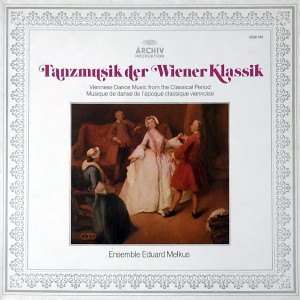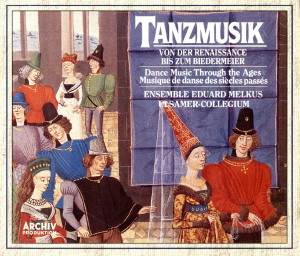 |
|
1 LP -
2533 182 - (p) 1975
|
 |
| 4 CD's -
439 964-2 - (c) 1992 |
|
| TANZMUSIK DER WIENER
KLASSIK |
|
|
|
|
|
|
|
| Viennese Dance Music from the
Classical Period |
|
|
|
|
|
|
|
| Joseph Eybler
(1764-1846) |
Polonaise |
Ms. Wien,
Österreichische
Nationalbibliothek, Sm 11 347 * |
|
2' 45" |
A1 |
| Joseph
Haydn (1732-1809) |
Menuett,
Hob IX/16/12 |
ed. R. Landon,
Doblinger, Wien, V-Nr. 12 867 |
|
2' 08" |
A2 |
| Joseph
Haydn |
Menuett,
Hob IX/11/4 |
ed. E. F.
Schmid, Kistner & Siegel,
Leipzig 1940 |
|
1' 59" |
A3 |
| Christoph Willibald
Gluck (1714-1787) |
Ballett
(aus "Orfeo ed Euridice") - Allegretto
(aus "Don Juan") |
ed. A. Hoffmann,
Kallmeyer 1937 |
|
3' 22" |
A4 |
| Wolfgang Amadeus
Mozart (1756-1791) |
Sechs
"Landlerische", KV 606 |
Mozart-GA, Serie
24, 16 |
|
4' 50" |
A5 |
| Paul Wranitzky
(1756-1808) |
Zehn "Deutsche" |
Ms. Wien,
Österreichische
Nationalbibliothek, Sm 11 189 *
|
|
7' 36" |
A6 |
| Wolfgang Amadeus
Mozart |
Fünf Kontretänze, KV 609 |
Mozart-GA, Serie
11, 23 |
|
7' 12" |
B1 |
| Ludwig van Beethoven
(1770-1827) |
Vier
Kontretänze, WoO 14 (Nr. 4,
12, 5, 7) |
Beethoven-GA,
Nr. 17a = Serie 2, 9 |
|
5' 19" |
B2 |
| Antonio Salieri
(1750-1825) |
Menuetto |
Ms. (autograph)
Wien, Österreichische
Nationalbibliothek, Sm 3767 * |
|
3' 40" |
B3 |
| Paul Wranitzky
|
"Quodlibet": |
Ms. Wien,
Österreichische
Nationalbibliothek, Sm 11 100 *
|
|
8' 20" |
B4 |
|
- Straßburger ·
Cosacca · Altvatter · Contredanse
· Fandango (nach Mozart, "Figaro")
· Masur · Russisch · Furlana
|
|
|
|
|
|
|
|
* = nicht ediert
|
|
|
|
| ENSEMBLE
EDUARD MELKUS |
| -
Eduard Melkus, Spiros Rantos, Solovioline |
| -
Roberta Elliot, Mikis Michaelidis,
Alexander Krins, Clemens Hellsberg,
Richard Motz, Wilhelm Jordan,
Michael Stüve, Violine |
| -
Nicolas Logie, Viola |
| -
Martin Sieghart, Elisabeth
Strachwitz, Violoncello |
| -
Alfred Planyavsky, Kontrabaß |
| -
Gerald Sonneck, Violone |
| -
Herbert Reznicek, Thomas Pinschoff,
Flöte |
| -
Walter Lehmayer, Gerhard Turetschek,
Oboe |
| -
Alfred Prinz, Roger Salandar, Klarinette |
| -
Dietmar Zeman, Fritz Faltl, Fagott |
| -
Friedrich Gabler, Gregor Widholm, Horn |
| -
Horst Berger, Helmut Ascherl, Schlagwerk |
|
|
|
|
Luogo
e data di registrazione |
|
Palais
Schönburg, Vienna (Austria) -
24/26 febbraio 1974 |
|
|
Registrazione:
live / studio |
|
studio |
|
|
Production |
|
Dr.
Andreas Holschneider |
|
|
Recording
supervision |
|
Werner
Mayer
|
|
|
Recording Engineer |
|
Klaus
Scheibe |
|
|
Prima Edizione LP |
|
ARCHIV
- 2533 182 - (1 LP - durata 47'
46") - (p) 1975 - Analogico |
|
|
Prima Edizione CD |
|
ARCHIV
- 439 964-2 - (4 CD's - durata 71'
35"; 70' 09"; 70' 42" & 72'
56" - [CD3 26-31; CD4 1-4]) - (c)
1992 - ADD
|
|
|
Cover |
|
Pietro
Longhi (1702-1785), "Der
Tanzmeister", Archiv für Kunst und
Geschichte, Berlin |
|
|
Note |
|
-
|
|
|
|
|
Viennese Dance
Music from the Classical
Period
Dance music is a phenomenon
which retains its fascination
quite apart from dance itself or
the pleasure of dancing. It
reflects the character both of a
certain epoch and of its people
who of ten in straightforward
works like these present
themselves in an informal light
and reveal much more of
themselves than they micht in
their great pieces of music
which whether consciously or not
aspire to immortality. This,
together with their general
pleasure and entertainment
value, iswhat in so intriguing
about these dances.
Amongst the dances native to
Austria in the later eighteenth
century there is, as well as the
courtly minuet, the popular
“ländler” (slow waltz) and the
faster “Dreher”, the so-called
“German dance”, out of which the
Viennese waltz grew. Of all the
dances in duple time, the
country dances are the most
important. Polish dances
(polonaise, polacca and mazurka)
are the most significant of the
dances coming from abroad; they
excited the interest of
composers as early as the
beginning of the eighteenth
century and, after the division
of Poland and the influx of
Polish nobility into court
circles in Vienna, Prussia and
Saxony, this interest was
reawakened. Joseph Eybler, a
friend of Mozart, wrote three
polonaises for a large
orchestra, one of which is
presented here. The
orchestration, modelled on
Beethoven, gives the dance a
grand ceremonial splendour such
as it still enjoys nowadays at
the great Viennese balls when
the polonaise opens the
proceedings.
One can find much clear,
spirited, well-balanced dance
music in works by Gluck, Salieri
and Haydn. Gluck gave the ballet
new impetus and was as much a
reformer here as he was in the
world of opera, In Gluck’s
operas dance plays an important
rôle; this is illustrated by the
"balletto" from the opera "Orfeo
ed Euridice", which is basically
a slow minuet. The "Allegretto"
from the ballet "Don Juan"
reveals Gluck’s flair for
writing lively dances in duple
time; in this case he lays down
the pizzicato for the strings,
making the piece sound like a
precursor of the pizzicato
polkas written later by members
of the Strauss dynasty.
Salieri, who is best known as
Beethoven’s and Haydn’s teacher,
and is alleged to have been
Mozart’s arch-enemy, was a
respected composer of
considerable ability. Whilst we
were looking through his
manuscripts in the Austrian
National Library, we came across
the minuet in B flat major
included here. Thematically
related to Gluck’s "balletto",
it seems a real find: a piece of
fine poise and classical mien.
Haydn’s minuets in contrast make
a more popular and robust
impression. The G major minuet
(Hob. IX 16/12) is actually a
German dance and has little in
common with a minuet. In the E
major minuet taken from the
"Katherine Dances" (Hob. IX
11/4) on the other hand we are
confronted with the classical
world; the radiance of the work
reveal this is the composer of
"The Creation" and "The
Seasons".
Mozart’s "Six Landlerlike
Dances" (KV 606) for two violins
and bass were composed in
February 1791 and belong to the
bourgeois provincial scene. They
are scored for a trio as was
usual in dance music: two high
stringed instruments and a
double bass (“Bassel”), just as
popular musicians used to play
at dances in local inns. For
dances at court and for great
balls the number of players was
increased and the scoring
included wind instruments.
Mozart captures the popular
sound in the most charming way,
forging a true link between
popular and classical music. The
"Contredances" (KV 609) also
date from the last years of his
life. In this case the
obligatory trio of two violins
and double bass is augmented by
flute and drum. The first of
these dances includes a
quotation from the famous aria
“Non più andrai” from "The
Marriage of Figaro", revealing
how well-known melodies were
transformed into dance music as
a matter of course. In these
"Contredances" three
straightforward dances are
followed by a Dreher in 3/8
time. Mozart adopted the pairing
of duple and triple rhythms
usual in popular music.
Only nine years separate these
compositions by Mozart from
Beethoven’s country dances, but
they are worlds apart. Even in
these slight pieces the power
and revolutionary spirit of
Beethoven’s personality are made
clear. The original manuscript
bears the heading, “Contredances
de L.v. Beethoven pour Monsieur
de Friedrich Nomé Liederlich”.
Dance No. 7 was included in the
ballet "Prometheus" (Op. 43),
acted as theme for the piano
variations Op. 35 (1802) and was
used in the finale of the
“Sinfonia Eroica” (1803/04). Our
selection groups together those
dances which belong together
because of their scoring (for
two clarinets, two bassoons and
strings). They also have a
formal element in common: a halt
in the middle of the dance. Such
fermata are found incidentally
not just in Beethoven’s dances
but in many other country dances
of the period. This
characteristic feature (like the
slow opening of the Vienna
waltz) compelled the dancers to
stop whilst in full swing and to
move slowly, which no doubt led
to the most amusing situations.
Some of the dances out of
Wranitzky's "Quodlibet" are
closely related to these country
dances. This is a collection of
various dances of the period,
including some very well-known
pieces (such as the "Fandango"
from Mozart’s "Figaro"), and it
seems very like a compendium of
the various forms of dance
during the eighteenth century.
The "Quodlibet" is probably an
extract from the ballet "Das
Waldmädchen" (The Woodland
Maiden) by Wranitzky. The first
dance, a "Strassburger" is like
a country dance but it is
followed by a leisurely
"Altvatter", the slow stepping
dance in triple time with a fast
after-dance in duple time (here
the pairing of the dances is in
the reverse order, three and
then two). A "Cosacca" with a
"Masur" and a "Russian" dance
provide ample evidence of
Eastern influence. Beethoven
wrote twelve piano variations
(WoO 71) on the theme in the
"Russian" dance, and Haydn too
used it in a piece as a
flute-clock; it probably
originated with the violinist
Jarnowic (Giornovichi,
1745-1804). It is interesting in
this dance how all the violin’s
effects using flageolet and
pizzicato are included in a
manner reminiscent of gypsy
music. The "Fandango" proves the
Spanish influence, and Italy is
represented by the "Furlana
veneziana". The "Quodlibet" also
includes an "English dance", a
precursor of the "Ecossaise", as
it was known later.
Wranitzky’s second opus in our
series consist of humorous
German dances using the most
extraordinary instruments. It
was no easy job puzzling out
what the names of the
instruments meant, and it was
finally only made possible with
the help of experts on popular
music and popular instruments;
furthermore someone had to be
found who was familiar with late
eighteenth century Viennese
jargon. The "bellows" turned out
to be a portable organ, the
"coffee grinder" was a chime of
bells, the "Rasteysen" was an
early version of modern metal
rods, the "Nadlpixl" (Tin of
Nails) a little pipe of the kind
one blows on a key, the
"Apolloleyer" a psaltery; the
"Leyer" was of course a
hurdy-gurdy. The only names we
recognized were the "Papageno
pipe" (pipes of Pan),
"kettle-drums" and "Tschinellen"
(small cymbals). Since there are
also two glasses of water in
unison included in the score,
these must have been real folk
dances.
Once again in this series of
dances from the Viennese
classical period the works are
played according to their
original scoring. The small
group of stringed instruments
(short-necked) provide the ideal
balance for the solo wind
instruments.
E.
Melkus - W. Gabriel
(Translated
by Jane Wiebel)
|
|
|

